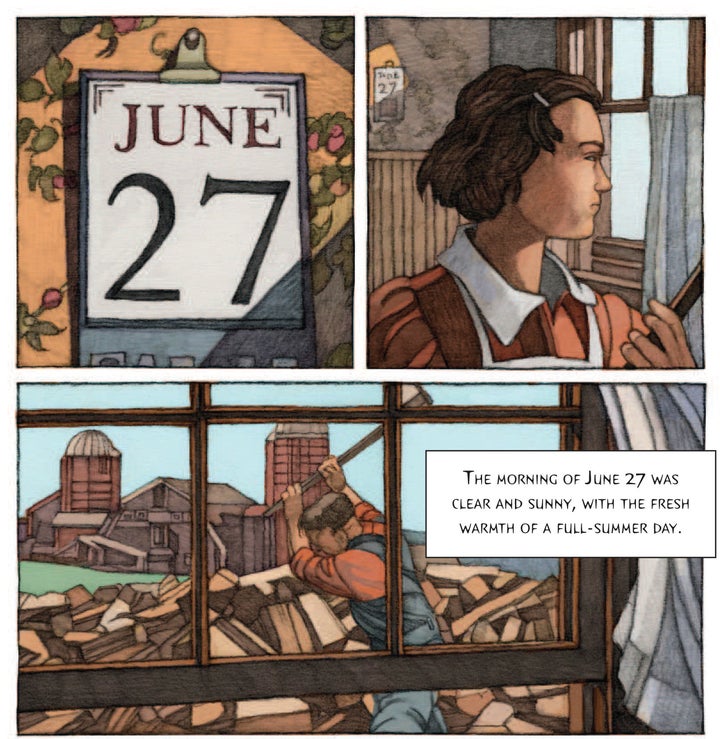
Shirley Jackson’s classic dystopian short story “The Lottery” ― often assigned in English classes, invoked when current events take a dark turn, and omnipresent in paeans to great short fiction ― holds a special place in the hearts of many readers. None more so, as it happens, than Miles Hyman, an illustrator and graphic novelist who also happens to be Jackson’s grandson.
In a brand-new graphic adaptation of “The Lottery,” Hyman translates his grandmother’s famously spare, unyielding prose into an implacably ominous visual journey through one day in a small town with a dark secret.
The unbearable suspense of the original short story derives from Jackson’s slow, detailed unspooling of the day’s events, all building toward the yearly lottery, juxtaposed with her coyness about what the lottery is or means ― even as unmistakable tension mounts amongst the townspeople. In his graphic adaptation ― which Hyman spent decades mulling over before attempting ― it’s a progression of scenes drawn from the book that lay the eerie groundwork. Without including much of the original text, or giving the whole game away, he depicts an ordinary little town that seems just slightly off-kilter, up until it becomes clear just how twisted the situation is.
In an email conversation, Hyman opened up to HuffPost about his approach to adapting “The Lottery,” his grandmother’s influence, and why the story remains so resonant. We’ve also excerpted several pages from the graphic adaptation to give just a glimpse into the creepy world Jackson created, and her grandson has reimagined:
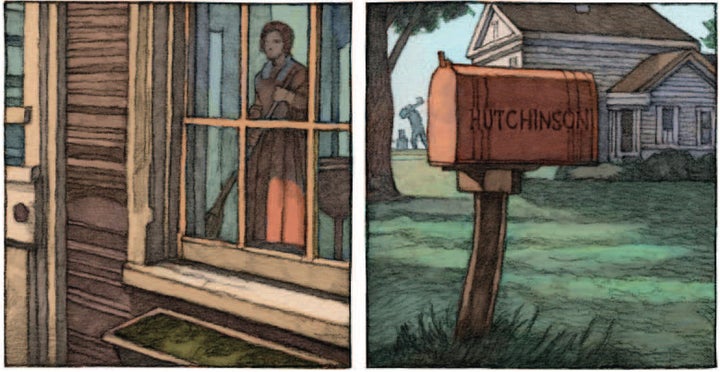
What made you realize that you could adapt “The Lottery” as a graphic novel, despite being hesitant to do so in the past?
It took me awhile because I knew it would be an important book for me and, in short, I really wanted to get it right. On one hand “The Lottery” is considered a masterpiece of short fiction and is widely read, a respected part of our American literary heritage. On the other it has tremendous importance ― like all of my grandmother’s writing ― to members of my family. (You wouldn’t exactly call it a “family heirloom,” but you see what I mean.)
So I was careful to set things in motion only when I felt that the graphic novel could really do something original and innovative with the story ― invite a new reading of this classic tale that has riveted but also inspired so many readers for generations. The folks at Farrar, Straus & Giroux (Hill and Wang) were excited about a graphic adaptation of the “The Lottery,” and their enthusiasm was a definite “plus” since I had worked with them in the past and knew the high quality of the books they produce. Their support was absolutely essential.
Part of what took a while to work out was what form the adaptation should take. I had felt for years that a more traditionally illustrated version would be an effective way to adapt the story, but something about that direction felt too static.
Then came the chance for me to work on a series of graphic novel adaptations, working with great texts such as Jim Thompson’s “Savage Night” and especially James Ellroy’s “The Black Dahlia.” I realized that this approach ― a graphic novelization ― would be an exciting direction for “The Lottery,” a format that would best allow me to convey the electric tension of the original story in a new way. My feeling was that if the adapted story was to develop the same seamless crescendo of intensity that the original does, it would be important to make the reader feel like they were right there in the crowd ― as if they were participating in the ritual themselves. A graphic novelization allows for that degree of proximity that illustration sometimes doesn’t.
What approach did you take to make use of the visual element to provide new insight to the story?
“The Lottery” is one of the most carefully constructed stories I’ve ever come across, so I knew that my drawings had to carefully respect the basic mechanics of the original text while rebuilding it as a graphic tale. This was no small task. In the original story much of the information shared with the reader about the ritual practice of the lottery itself is communicated with the help an omniscient narrator. However with graphic fiction you generally want to avoid over-using blocks of narrative text if at all possible. Action and dialogue tend to be much more effective storytelling tools when adapting a text in graphic form.
So I made the decision to “tease out” the opening scenes of the graphic novel with a series of nearly text-less sequences, based on small snippets of the original story. It’s in these scenes that we get the bulk of our key information ― the essential visual landmarks that are going to help us navigate the action going forward.

For instance, the opening scene of the graphic novel introduces us to Mr. Summers and Mr. Graves, who meet in the dead of night to prepare the ceremony in the store-room of Mr. Summers’ coal store. This new scene is actually inspired by a simple sentence of the original story that struck me as having a potentially strong visual impact, but which also lays the groundwork for what’s to come by allowing the reader of the graphic novel “sit in” on this late-night encounter, in a sense.
As a result we have important visual elements in mind from the get-go: We meet two of the key characters and see them preparing the black box that has been sitting on a dusty storeroom shelf for the last 364 days. We’re able to observe the folding of these curious pieces of paper that are going to be so important moving forward. And above all, we watch the men marking one of those pieces of paper with a mysterious black dot. The theatrical principle known as “Chekhov’s Gun” comes to mind. We’re left with a gut feeling that this strange marked paper, visible for an instant and then hidden away in the black box in the first scene of the graphic adaptation, will inevitably have some sinister impact on the story as events unfold. And, of course, it does.
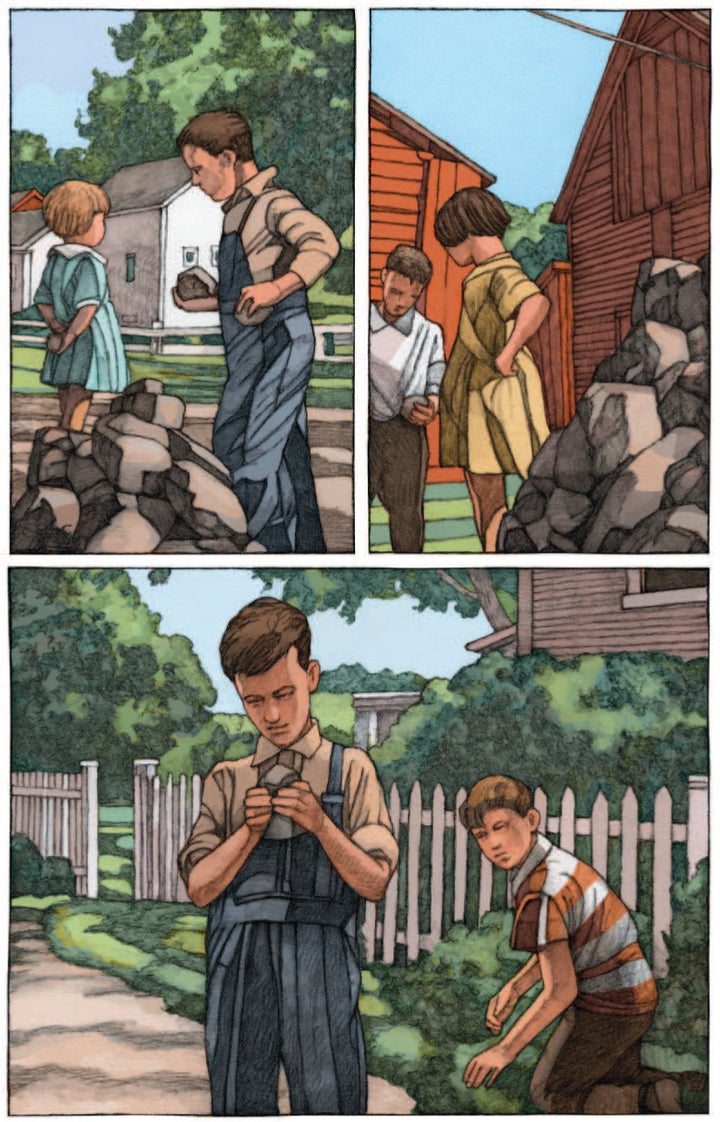
Beyond developing a familiar setting for the decor and characters in the earliest passages of the graphic novel, the main challenge in adapting “The Lottery” revolved around creating the right choreography for the lengthly, increasingly vivid exchange between the various villagers as the ritual draws to its terrifying conclusion. That’s where my fondness for unusual angles, composition and lighting came into play!
I have to admit that I very much enjoyed making that scene work as a graphic experience for the reader. As a “spectator,” we’re constantly moving in and out of the crowd, alternating close-ups on facial expressions with wide-angle views of the village and its inhabitants grouped together in the square, as if we were simultaneously a participant in the event and a neutral observer. Working with this part of the story was a challenge but also great fun to do. It feels like the adaptation does something I’m particularly proud of. By creating “The Lottery” as a visual experience, we’re able to see aspects of the story from a new and sometimes unexpected point of view, giving the reader a new take on a story so many of us thought we knew by heart.
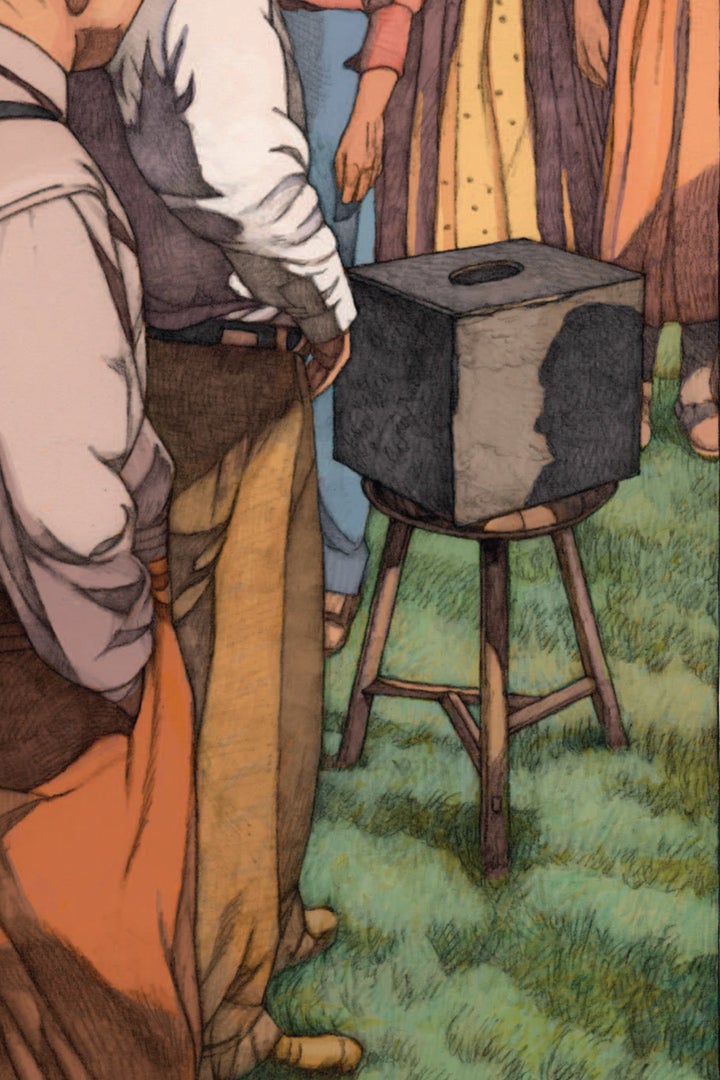
How did you adapt your artistic style to fit the literary style of “The Lottery”?
When readers of The New Yorker discovered the story in June 1948, many of them believed they were not reading fiction at all but an eyewitness account of something Shirley Jackson had just experienced a few days earlier.
In her essay “Biography of a Story,” my grandmother spoke about how surprised she was by the letters she received, asking for (and sometimes demanding) details about the ceremony. Many curious readers actually wanted to come watch the following year’s lottery in person! I think that the simple, meticulous quality of her writing explains part of the shock readers feel when they first experience the story, and I felt like the drawings ― while not hyper-realistic in style ― needed to be realistic enough that we might feel they were inspired by observed events.
So while I’ve sometimes used a more stylized sort of drawing in my previous graphic novels, in the case of my adaptation of “The Lottery” I was careful to stay as close as possible to a style of drawing that looks generally more realistic than other books of mine.

What influence, if any, has your grandmother’s work had on you as an artist?
With time, I’ve come to notice quite a few parallels between my grandmother’s work and my own. I do all sorts of illustration, for a wide variety of publishers, but perhaps what I like best tends to be that intense interplay of light and shadows that has come to typify so much of my work. As a result, publishers tend to associate my work with certain genres ― detective novels, horror stories, etc. This being said, like Shirley Jackson’s work, there is also a contrasting lighter side to my work that is equally important ― children’s books, editorial pieces.
I admire my grandmother’s ability, even in her most terrifying novels, to include elements of dark comedy. I think we share a common taste for this paradoxical blending of humor and horror. Whether it’s an artistic influence or just a family trait is up for debate, but I certainly recognize a common artistic taste for these qualities that would generally seem mutually exclusive.
This graphic adaptation of “The Lottery” will be publishing less than a month before a very controversial presidential election in the U.S. Do you think the book has any useful lessons for voters or citizens today, in particular?
Hmm ... I wouldn’t want to draw any direct parallels between a short story written in 1948 and our current political environment. Any analogies would obviously be imperfect at best and the last thing I’d want to do would be to bend the story’s meaning to address current events. As my grandmother might have said, “The Lottery” is just a story.
This being said, the story in question has clear allegorical qualities that make its meaning timeless. Part of the tale’s impact comes from its ability to speak to something broader and deeper than the fictional events it describes. Those elements are what has made the story so unsettling to people over the years. I guess “The Lottery” speaks to something latent in all of us, whether or not we choose to face it.
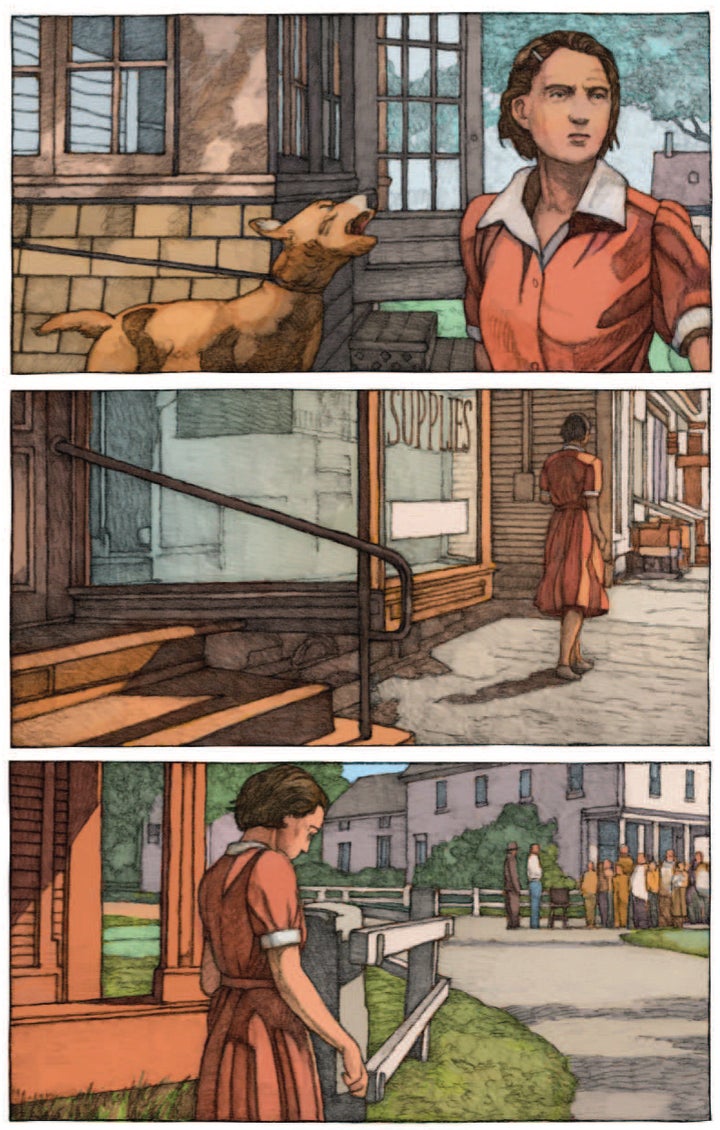
Jackson explores our proclivity to bow to rote tradition and ritual out of fear ― or, worse still, out of complacency, perpetuating conventions that are not only archaic but downright inhuman simply because we lack the courage to change them.
Something tells me my grandmother had many things on her mind when she wrote this dark tale in 1948: the country was still traumatized from an apocalyptic World War, coming to terms with the unimaginable horror of the Holocaust. Jim Crow-era legislation continued to segregate citizens based on the color of their skin, while “red scare” policies began persecuting some Americans based on their political convictions. Economic gains brought prosperity to much of the nation but fear, entrenched hatred and archaic conventions determined much of the rigid social and political boundaries that dominated our country during these conservative post-war years. It doesn’t sound like anything we’d want to go back to.
My grandmother always turned down her readers’ requests to explain the meaning of “The Lottery.” Evoking her refusal to do so in his introduction to the posthumous omnibus The Magic of Shirley Jackson my grandfather, literary critic Stanley Edgar Hyman, recalled her pride upon learning that the Apartheid-era Union of South Africa had banned “The Lottery.” According to my grandfather she allowed herself a rare enigmatic quip in reaction to the news: “At least they understand the story,” she said.
At work in my studio over the last year, listening to a steady stream of radio news as the graphic adaptation of “The Lottery” took shape on my drawing table, I couldn’t help but be struck by how pertinent this short story continues to be today, nearly 70 years after its original publication. Never in my lifetime have we seen a political environment so laced with those old toxic emotions: fear and hatred. Seen through the eyes of my grandmother’s classic tale, some of what has been said during this election cycle has, if anything, taken Old Mr. Warner’s irate rants to a whole new level of shrill demagoguery.
You could argue that “The Lottery” has only one hero: the reader. The story’s ultimate goal is perhaps to “shock us awake,” so that we might be moved to act differently the next time we’re confronted with stale ideas that perpetuate senseless cruelty, bigotry or injustice. If anything positive should come from the harrowing spectacle of watching our political discourse degenerate into reality TV, perhaps the current election cycle ― like the reading of my grandmother’s dystopic tale of horror ― might just shock us awake as a nation, encouraging us to move together beyond this dark and ugly place we seem to be in.
But, again: “The Lottery” is just a story.
This interview has been edited.

